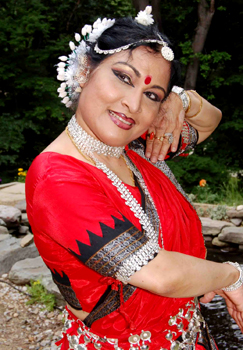 Mitra Purkayastha, an Odissi dancer, famous all over the world. She belongs to a family of artists and musicians. Mitra Purkayastha is privileged to have received training with some of the renowned gurus of the city of Kolkata. Starting from a very tender age, Mitra started to learn classical vocal music under the supervision of her parents. Guru Deborah Biswas and Smt. Maya Sen trained Mitra Purkayastha further in Rabindra Sangeet. The Odissi training of Mitra started with Guru Padmasri Murlidhar Majhi. The lady has trained herself with the Guru for several years and still continues to look for his blessings and guidance in all her endeavors.
Mitra Purkayastha, an Odissi dancer, famous all over the world. She belongs to a family of artists and musicians. Mitra Purkayastha is privileged to have received training with some of the renowned gurus of the city of Kolkata. Starting from a very tender age, Mitra started to learn classical vocal music under the supervision of her parents. Guru Deborah Biswas and Smt. Maya Sen trained Mitra Purkayastha further in Rabindra Sangeet. The Odissi training of Mitra started with Guru Padmasri Murlidhar Majhi. The lady has trained herself with the Guru for several years and still continues to look for his blessings and guidance in all her endeavors.
Apart from Odissi, Mitra has also learnt Manipuri dance under the guidance of Guru Khelendra Mukherjee, and also trained herself in Bharatnatyam and Kathak. Mitra Purkayastha was a part of the dance troupe of late Manjusri Chaki Sirkar; dancers guild having specialization in the creative contemporary choreography. She used to be among the major dancers of the troupe. There are several dance degrees attained by Mitra Purkayastha including the Sangeet Prabharak, Sangeet Sudharak and Sangeet Visharad. Mitra also holds a Masters degree in English and Indian History from University of Calcutta and a Masters and M.Litt in European History from the Drew University. After performing for several years as a soloist, Mitra had the proper training to move into the profession of teaching. She carried on classes in Minnesota and Houston before getting herself relocated to New Jersey.
Mitra Purkayastha possesses a very strong and diverse interest in the classical music of India, and she studied Indian classical music from her parents, Sunirmal and Sandhya Purkayastha, who were the adherents of the reputed Ustad Magat Raj Bhagat of Tilmandi Gharana, the state musician of Rajasthan. Mitra also received lessons on Rabindra Sangeet under the able guidance of Debabrata Biswas and Maya Sen of Kolkata.
One of the eminent Odissi dancers in the world, Mitra Purkayastha is also famous as a teacher and a choreographer based in New Jersey. She started her long teaching career in the year 1979 in the United States and in the year 1986, she initiated her presently famous dance school called Rhythms of Dance and Music in Morristown, New Jersey. In the year 2007, Mitra celebrated twenty years of Rhythms of Dance and Music, her dance school. In this event, she got together with the well-known Toronto based choreographer, Sukalyan Bhattacharya to present a very successful show. In the month of April 2009, at the esteemed dance festival, Zalak organized by Marathi Vishwa in Princeton, NJ, Mitra Purkayastha along with her students were privileged to win the first prize.
In the world of dance and also in the publishing industry, Mitra Purkayastha possesses an extremely successful career. Mitra complies with the Japanese Suzuki model-early beginning, rote learning and parental participation. She deeply believes that age is not a barrier in learning dance and it has greatly encouraged several mother-daughter duos to get the lesson of dance together. With untiring passion, Mitra Purkayastha is engaged in her work of training a number of dancers in the tri-state area. Her wide-ranging dance background and marvelous enthusiasm has really helped a lot in shaping the life of a number of young talents. The guidance and encouragement of Mitra contributed a lot in shaping the life of Nilanjana Banerjee, a famous Odissi dancer and one of the students of Mitra Purkayastha. Nilanjana still seeks the blessings and grace of her guru, Mitra.
According to Mitra Purkayastha, dance is a passion and it provides completeness and ecstasy to her inner self, i.e. her body, mind and soul. She considers dance to be her peace, power and prayer offered to the almighty. As per Mitra, the form of dance is still continuing the rich Indian tradition of the Guru and Shishya parampara, which means the passage of the teachings of the Guru to the disciples or Shishya. Here the famous shook by Adu Sankaracharya can be mentioned, which reads; `Guru Brahma, Guru Vishnu, Guru Devo Maheshwara, Guru Sakshat Parambrahma, Tasmai Shree Gurave Namaha`. The meaning of this shook is that Guru is regarded as the creator or Lord Brahma, Guru is also the restorer as Lord Vishnu and at the same time Guru is also the destroyer as Lord Shiva. Guru is thus the absolute spirit and I offer my prayers to this great Guru who is no less important than the Lord. One can have several gurus for various dance styles, but one needs to have a single Guru for each style. It is better to attain a workshop, but a Guru is essential to nurture the immense potential of growth and enrichment in an individual, and can guide one to the perfect path.
Mitra Purkayastha considers a Guru as someone who has huge patience and a great power of motivation so that the disciples or students can trust themselves. In fact the greatest achievement in the part of a guru is not only winning accolades, prizes and awards, but also to see the students flower into confident dancers with an eternal passion for their form of art, and thus they can move ahead to achieve excellence. Mitra Purkayastha states that teaching dance to disadvantaged children is one of her personal challenges which she enjoys to fulfill with an open heart.



















